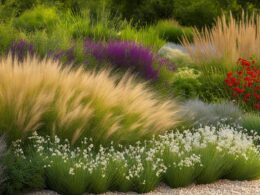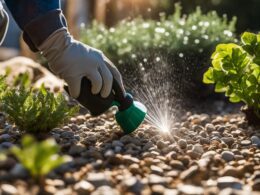Xeriscaping is a landscaping technique that focuses on conserving water while enhancing the outdoor aesthetics of your property. By implementing xeriscaping principles, you can save water, reduce your water bill, and contribute to a more eco-friendly environment. This article will guide you through the seven principles of xeriscaping, providing you with the necessary information to create a water-efficient and visually appealing landscape.
Key Takeaways:
- Xeriscaping is a landscaping method that aims to conserve water and enhance outdoor aesthetics.
- Implementing xeriscaping principles can help you save water and reduce your water bill.
- Xeriscaping promotes an eco-friendly environment by using water-efficient practices.
- By following the seven principles of xeriscaping, you can create a visually appealing and sustainable landscape.
- Xeriscaping is a beneficial landscaping technique that benefits both the environment and your wallet.
The Importance of Water Conservation in Landscaping
Water use in landscaping, particularly outdoor watering, is a significant contributor to domestic water consumption, especially during the summer months. In fact, more than 50% of summer domestic water use in cities in the Southwest is dedicated to irrigating landscapes. This overreliance on potable water for irrigation not only strains our water resources but also drives up water bills and contributes to environmental issues.
Recognizing the need for change, it is crucial to adopt strategies that promote water conservation in landscaping. One effective approach is xeriscaping, a landscaping technique that focuses on creating visually appealing landscapes while minimizing water use. By implementing xeriscaping principles, you can reduce or even eliminate the need for potable water in landscape irrigation.
Xeriscaping achieves water conservation in landscaping through various measures. Firstly, it involves reducing the irrigated area by incorporating hardscapes or low-water-use plantings. Additionally, xeriscaping promotes the use of recycled or low-quality groundwater for irrigation, reducing the demand for potable water. Another essential aspect is the implementation of efficient irrigation systems, such as drip irrigation or subsurface drip systems, which deliver water directly to the plant roots, minimizing evaporation and ensuring efficient water use.
In addition to these measures, xeriscaping also encourages the use of plants that are adapted to the local climate and require less water to thrive. By selecting water-efficient plant material, you can create a sustainable landscape that not only conserves water but also enhances the beauty of your outdoor space. With xeriscaping, you can make a positive impact on both your wallet and the environment, achieving a balance between outdoor aesthetics and water conservation.
Understanding Xeriscape Design and Principles
Xeriscape is a landscaping concept that has gained popularity in water-scarce regions. It is a water-efficient design that incorporates horticultural practices suitable for arid environments. By understanding the principles of xeriscape design, you can create a visually appealing and sustainable landscape that conserves water and minimizes maintenance.
Xeriscape design is based on seven key principles:
- Planning and design: This involves assessing your landscape’s needs, considering water efficiency, and incorporating elements such as walkways, seating areas, and focal points.
- Efficient irrigation: Implement irrigation systems that minimize water waste, such as drip irrigation or subsurface drip systems.
- Use of mulch: Apply organic mulch materials, like bark or compost, to cover the soil, reduce evaporation, and suppress weed growth.
- Soil preparation: Enhance the soil’s water-holding capacity by incorporating organic materials and making necessary amendments based on the specific needs of the plants.
- Appropriate turf: Limit the use of turf grass to areas where it is necessary, and consider using low-water-use turf varieties.
- Water-efficient plant material: Choose native or drought-tolerant plants that can thrive with minimal water requirements, grouping them based on their water needs.
- Appropriate maintenance: Regularly maintain your xeriscape landscape, including proper watering, pruning, and fertilizing, to ensure its health and beauty.
By adhering to these principles, you can reduce your outdoor water consumption significantly while creating a beautiful and sustainable landscape that is tailored to arid environments.
Benefits of Xeriscape Design
Xeriscape design offers several benefits, including:
- Water conservation: By implementing water-efficient practices, xeriscape design reduces outdoor water consumption, saving both money and valuable resources.
- Lower maintenance: Xeriscape landscapes require less maintenance compared to traditional landscapes, reducing the need for mowing, watering, and fertilizing.
- Enhanced aesthetics: With careful planning and design, xeriscapes can be visually appealing, featuring a variety of plants, textures, and hardscape elements.
- Environmental sustainability: Xeriscape design promotes ecological balance by utilizing native plants, reducing the use of pesticides and fertilizers, and conserving water.
- Improved property value: Well-designed xeriscapes can enhance the curb appeal of your property and increase its value.
By understanding and implementing xeriscape principles, you can create a landscape that not only conserves water but also offers long-term benefits for your property and the environment.
Planning and Designing a Xeriscape Landscape
When it comes to creating a xeriscape landscape, careful planning and design are essential. By considering factors such as function, water efficiency, cost, personal preferences, and maintenance requirements, you can ensure a successful project. Start by mapping out your landscape and dividing it into zones with different water requirements. This approach, known as hydrozoning, allows you to tailor your watering practices to specific areas, optimizing water usage.
Rainwater harvesting is another crucial aspect to consider during the planning phase. By directing runoff from roofs and other surfaces into storage systems, you can reduce the need for supplemental irrigation. Implementing rainwater harvesting not only conserves water but also helps you become more self-sufficient in maintaining your xeriscape landscape.
“A successful xeriscape begins with careful planning and design.”
Furthermore, the planning phase is an ideal opportunity to set a budget and timeline for your project. If needed, you can implement the work in stages to manage costs effectively. Remember that xeriscaping is a long-term investment, and a well-thought-out plan will contribute to the longevity and success of your water-efficient landscape.
Implementing Efficient Irrigation Systems
When it comes to xeriscaping, efficient irrigation systems are essential to minimize water waste and ensure water use efficiency. Two popular options for xeric landscapes are subsurface drip systems and drip irrigation. These systems deliver water directly to the roots of plants, reducing evaporation and ensuring that every drop counts.
Subsurface drip systems are installed beneath the soil surface, delivering water through a network of drip lines. This method not only prevents water loss due to evaporation but also reduces weed growth caused by overspray. Drip irrigation, on the other hand, uses individual emitters to deliver water directly to each plant. This precise delivery system ensures that water is used efficiently and minimizes runoff.
To manage irrigation effectively, it is important to separate different water-use zones with individual valves. This allows you to customize the amount of water delivered to each zone based on the specific needs of the plants. By implementing these efficient irrigation systems, you can conserve water while promoting healthy plant growth in your xeriscape landscape.
Benefits of efficient irrigation:
- Minimizes water waste
- Reduces evaporation and overspray
- Promotes water use efficiency
- Prevents weed growth caused by overspray
By choosing the right irrigation system and properly managing water use, you can create a sustainable and visually appealing xeriscape landscape that conserves water and supports the health of your plants.
Using Mulch and Preparing the Soil
One of the key components of a successful xeriscape landscape is the use of mulch and proper soil preparation. Mulch plays a crucial role in conserving water and creating a healthy growing environment for your plants. It covers the soil, reducing evaporation, erosion, and weed growth, while also helping to maintain soil moisture. To ensure effective water retention, it is recommended to apply mulch several inches thick throughout your landscape.
When selecting mulch materials, opt for organic options such as bark, compost, or grass clippings. These materials not only retain moisture but also contribute to improving the overall health of your soil over time. Using organic mulch promotes the decomposition of organic matter, which enriches the soil and facilitates better water retention. Mulching also acts as a natural insulator, protecting plant roots from extreme temperature fluctuations.
Soil preparation is equally important in a xeriscape landscape. Enhancing the water-holding capacity of your soil can significantly benefit your plants’ health and growth. Incorporate organic materials, such as compost, into the soil to improve its structure and nutrient content. This will help the soil retain more water and provide essential nutrients to your plants.
Benefits of Using Mulch and Preparing the Soil:
- Reduces water evaporation from the soil surface
- Prevents erosion by protecting the soil from heavy rainfall
- Inhibits weed growth, reducing competition for water and nutrients
- Improves soil structure and fertility
- Enhances water-holding capacity
- Provides insulation for plant roots
By using mulch and preparing your soil properly, you create an environment that promotes water retention and supports the healthy growth of your plants. These simple practices are essential for maintaining a thriving xeriscape landscape while minimizing water usage. So, take the time to mulch and prepare your soil, and enjoy the benefits of a water-efficient and visually appealing outdoor space.
What are the best xeriscaping principles to use with low-water plants for water conservation?
When using lowwater xeriscaping plants for water conservation, it’s best to follow xeriscaping principles such as planning and designing with water-saving plants, using efficient irrigation methods, and improving soil quality. Mulching and proper maintenance are also essential for creating a sustainable and low-maintenance landscape.
Importance of Water-Efficient Plants and Maintenance
Now that you understand the principles of xeriscaping and have planned and designed your landscape, it’s time to focus on the importance of selecting water-efficient plants and practicing appropriate maintenance. These two factors play a crucial role in the success of your xeriscape.
When it comes to choosing plant materials, opt for water-efficient options such as native plants or species that are known to thrive in arid climates. These plants have adapted to survive with minimal water requirements, making them perfect for a xeriscape. By selecting water-efficient plants, you not only conserve water but also create a visually appealing landscape that can thrive even in challenging conditions.
Proper maintenance is essential to keep your xeriscape landscape healthy and beautiful. Regular watering, pruning, and fertilizing are all part of the maintenance routine. However, it’s important to adjust your watering schedule to meet the specific needs of your water-efficient plants. Overwatering can be detrimental, so be sure to follow appropriate watering guidelines for each plant species. Additionally, regular pruning and fertilizing will help promote healthy growth and prevent any potential issues.
By implementing xeriscaping principles, including the use of water-efficient plants and practicing appropriate maintenance, you’ll reap the benefits of a sustainable and visually appealing landscape. Not only will you contribute to water conservation efforts, but you’ll also enjoy the long-term cost savings and the satisfaction of creating an environmentally friendly outdoor space.













